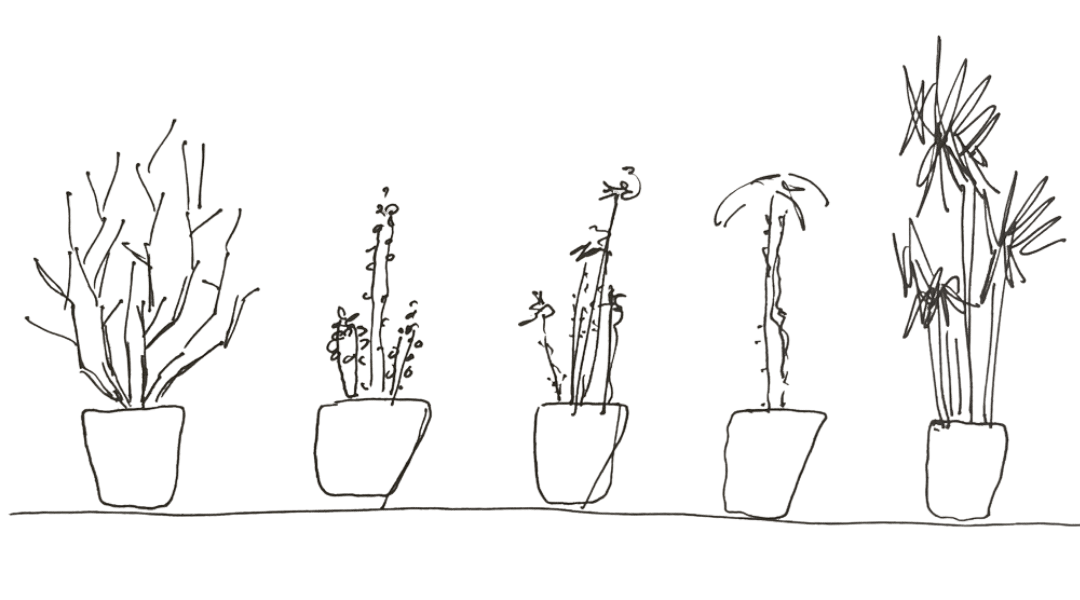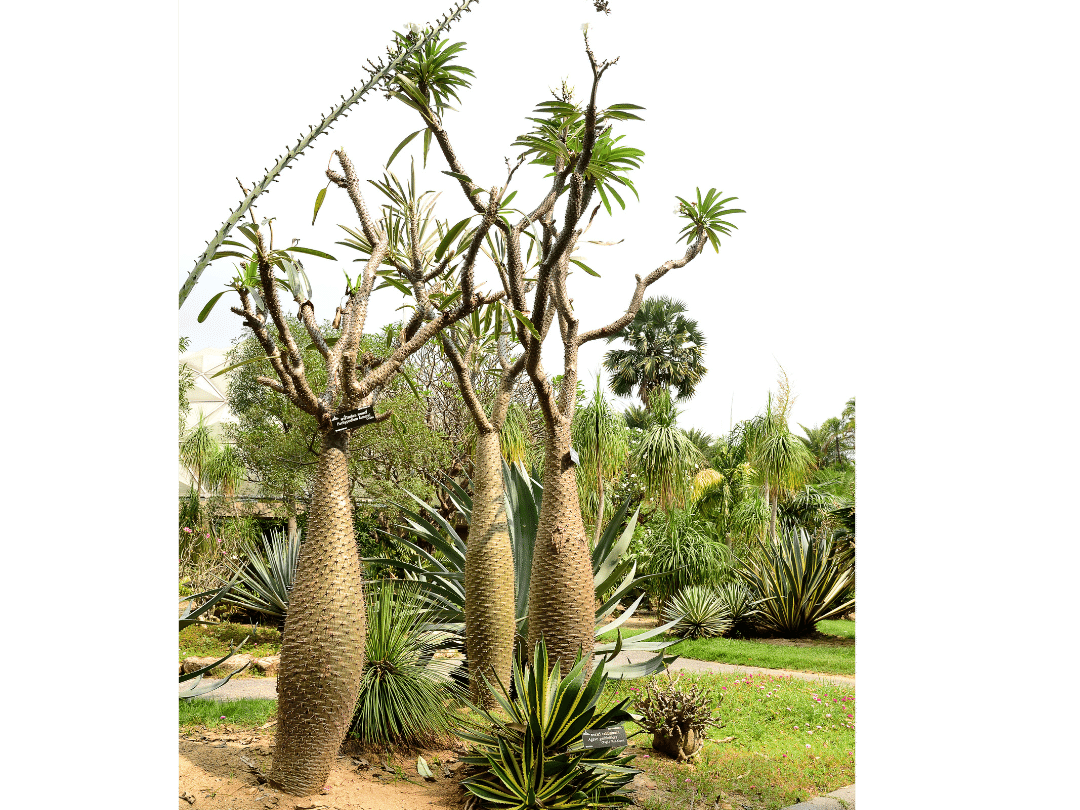Tall succulents come in many forms. Some grow long stems. Some have a flower that shoots into the sky. And some succulents are just plain tall.
There is a type of cactus, for example, that can get 30’ tall. It is the Pachycereus pringlei, Mexican giant cardon, in case you were wondering.
And the African Baobab tree is a succulent that can reach 62’!
According to Britannica, a succulent is:
“Any plant with thick fleshy tissues adapted to water storage. Some succulents (e.g., cacti) store water only in the stem and have no leaves or very small leaves, whereas others (e.g., agaves) store water mainly in the leaves.”
These succulents are indeed juicy.
There are around 60 different plant families that contain succulents, so let’s talk about some of the most popular garden succulents that rise above the rest. You may have spotted these low maintenance and drought tolerant plants in a garden or container. Karen, my blog partner, even has a few of these!
5 Tall Succulents
Let’s start with Euphorbia! There are three tall Euphorbia succulents that are commonly used, including Euphorbia tirucalli (Sticks on Fire), Euphorbia milii (Crown of Thorns), and Euphorbia trigona (African Milk Tree).
Euphorbia tirucalli
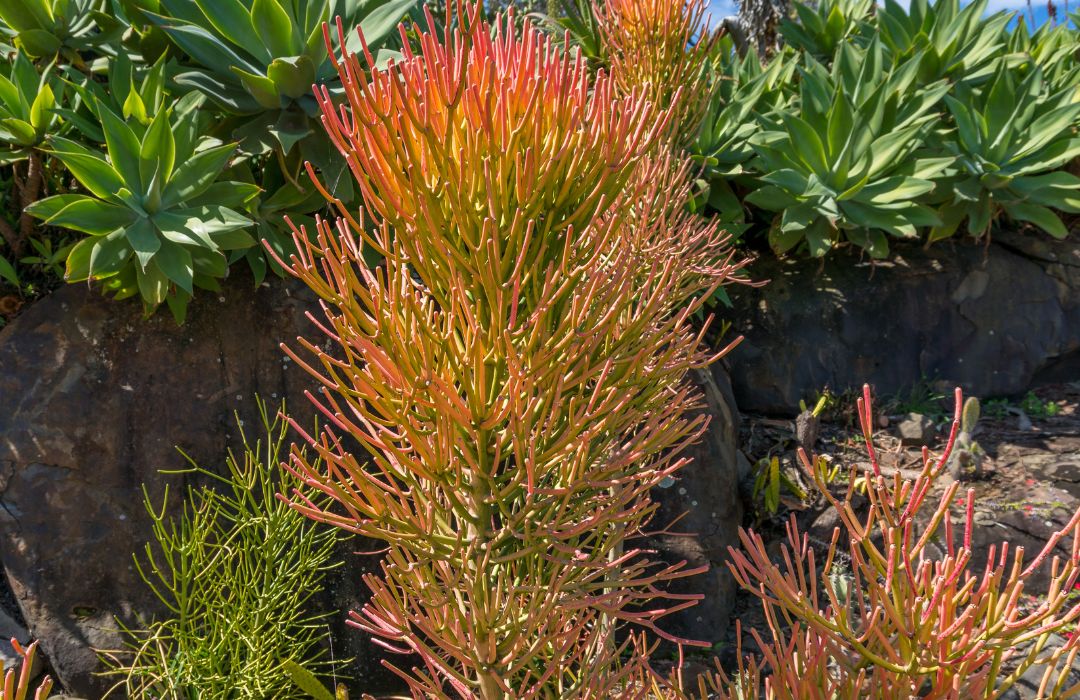
Euphorbia tirucalli (yew-FOR-Bee-ah tie-roo-KAH-lee) is commonly referred to as Sticks on Fire or Pencil Plant. It is a tall and colorful succulent that can reach 40’ in its native environment. This plant typically reaches about 10’ tall and 5’ wide in Southern California.
It is very easy to spot plant. The distinctive succulent is made up of pencil-like stems that can range from green to a colorful display of yellows, to oranges, and then reds.
Indoors or in a container, this tall succulent will reach about 6’.
As a houseplant, this big succulent will need the sunniest place you can find.
This is a tremendously popular succulent. I can go to my local grocery store and spot some in the mixed succulent pots they sell.
Euphorbia milii
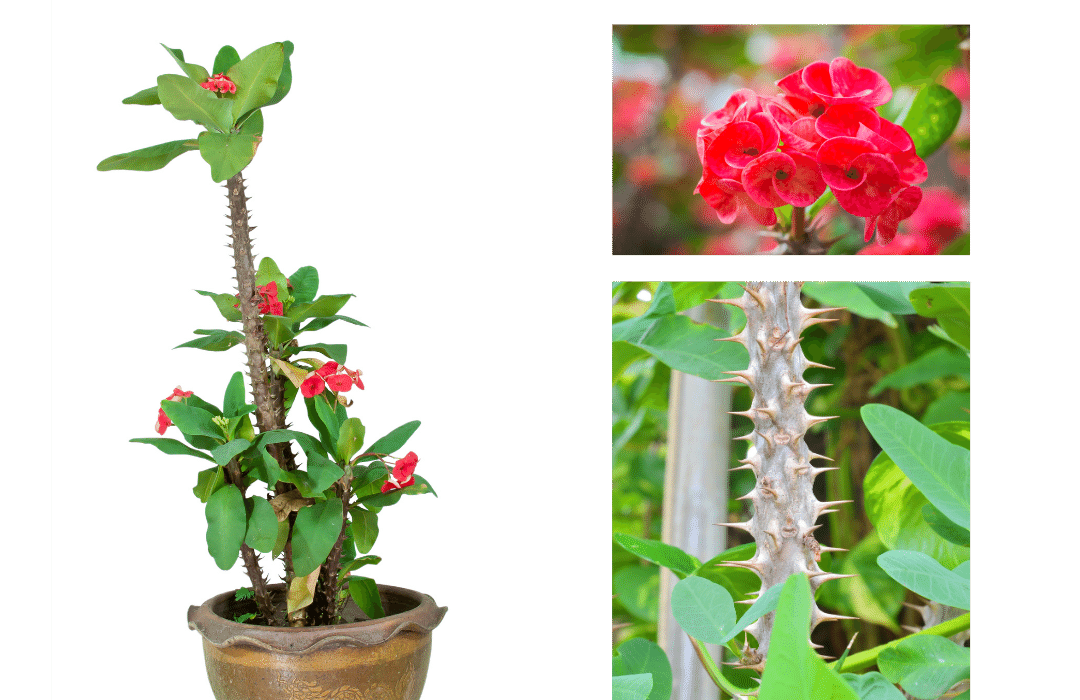
Euphorbia milii (yew-FOR-Bee-ah MIL-ee-eye) is another tall type of succulent. This one can reach 6’ tall in the perfect outdoor spot, but will tap out at about 3’ indoors.
The common name for this tall succulent is Crown of Thorns, Christ Plant or Christ Thorn. This is because, according to religious legend, Jesus Christ used the stems of this plant as a crown.
This easy to grow succulent has a thick stem with thorns that are topped with green leaves and flowers.
When you buy Euphorbia tirucalli, you won’t find the cultivars you find in other plants like Euphorbia milii. This could be due to the fact that unlike Sticks on Fire, Crown of Thorns is usually grown for its flowers, which bloom year-round.
This euphorbia includes a wide range of plant sizes and flower colors. It can be dwarf, or almost spineless. It can have red flowers (the original color) or flower colors from white to cream and yellow to many shades of pink and red.
Euphorbia trigona
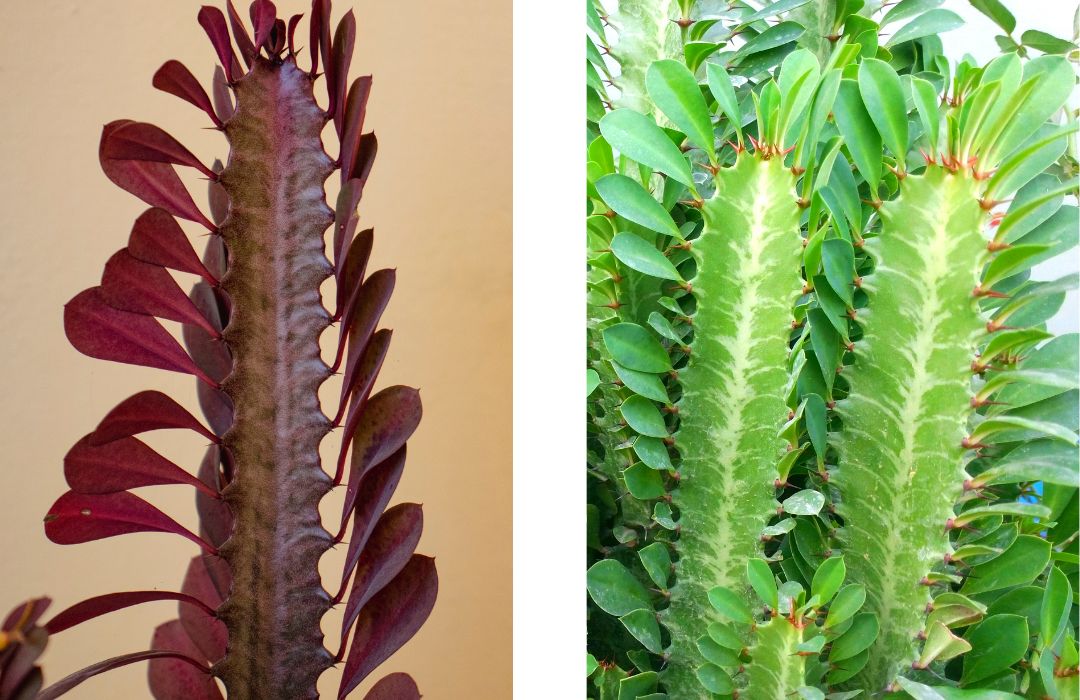
Another tall succulent you may want to choose for your home or garden is Euphorbia trigona (yew-FORB-ee-ah try-GOH-nuh).
Before you get stressed about too many choices in this tall, sculptural and upright succulent, I should tell you that there are just two main varieties of this plant: Euphorbia trigona and Euphorbia trigona rubra. Which means you just have to decide if you want a green one or a deep red one.
While limited on cultivars, this plant is not limited on common names. This euphorbia can be referred to as African Milk Tree, Cathedral Cactus, Luck Plant, Friendship Cactus, Candelabra Cactus, and Abyssinian Euphorbia.
It can grow to 9’ outdoors but usually stays below 4’ indoors or in a container. This plant also has thorns.
Before you buy any of these three Euphorbia, keep in mind that Euphorbia are very toxic plants! The list of warnings with these plants is like the small print on medication:
- White milky sap is a skin irritant and poisonous
- Protect eyes and mouth when handling it
- Wash immediately if in contact with the skin
- Severe gastric distress may occur if ingested
- Keep pets and children away
Yucca Gigantea
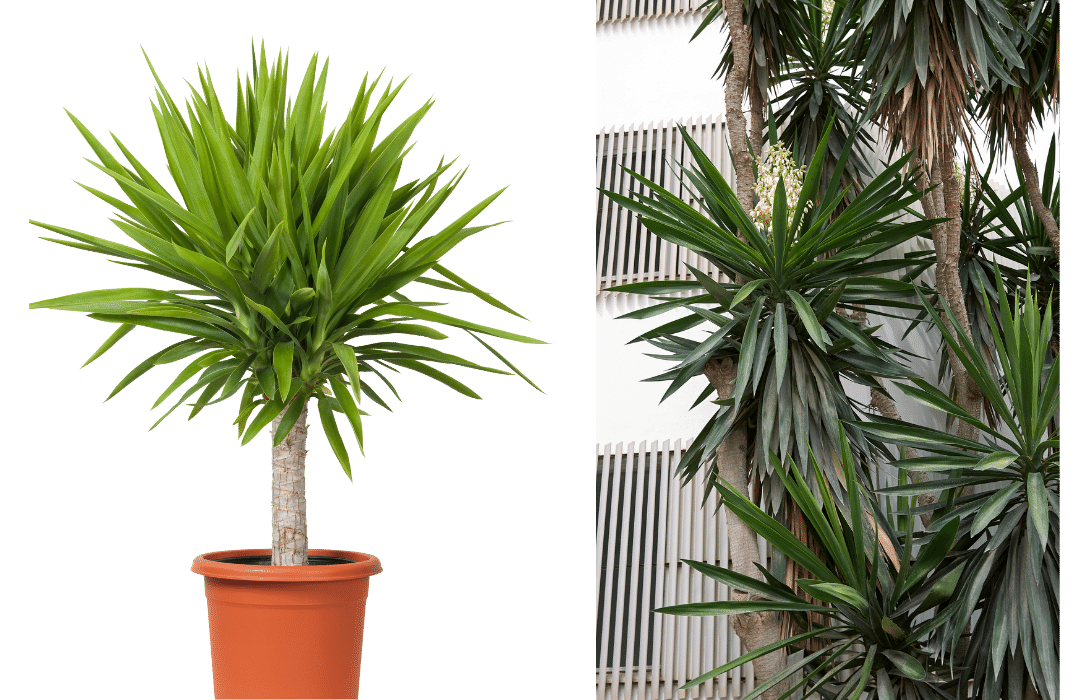
First, yucca is a pretty yucky name for a plant.
While there are many yuccas to choose from, Yucca gigantea (also known as Y. guatemalensis and Y. elephantipes) is the tallest of the yuccas.
Don’t let the small size of the plant in the nursery fool you, this plant can become a huge succulent, getting up to 40’ tall and 25’ wide. Although indoors or in a container, it will get less than half that size.
This very tall succulent is Native to Mexico and Central America. Unless you’re in a very temperate climate like zones 12, 13, 16, 17, 19-24, H1 and H2, you’ll need to leave this plant inside in a very sunny location
This succulent is widely cultivated and often referred to as yucca cane.
The flower of this tall yucca is edible. Called izote, it is the national flower of El Salvador and is used extensively in Salvadoran cuisine. If you want to give it a try try, use the petals, not the anthers or ovaries of the flower. The latter are too bitter.
Pachypodium Lamerei
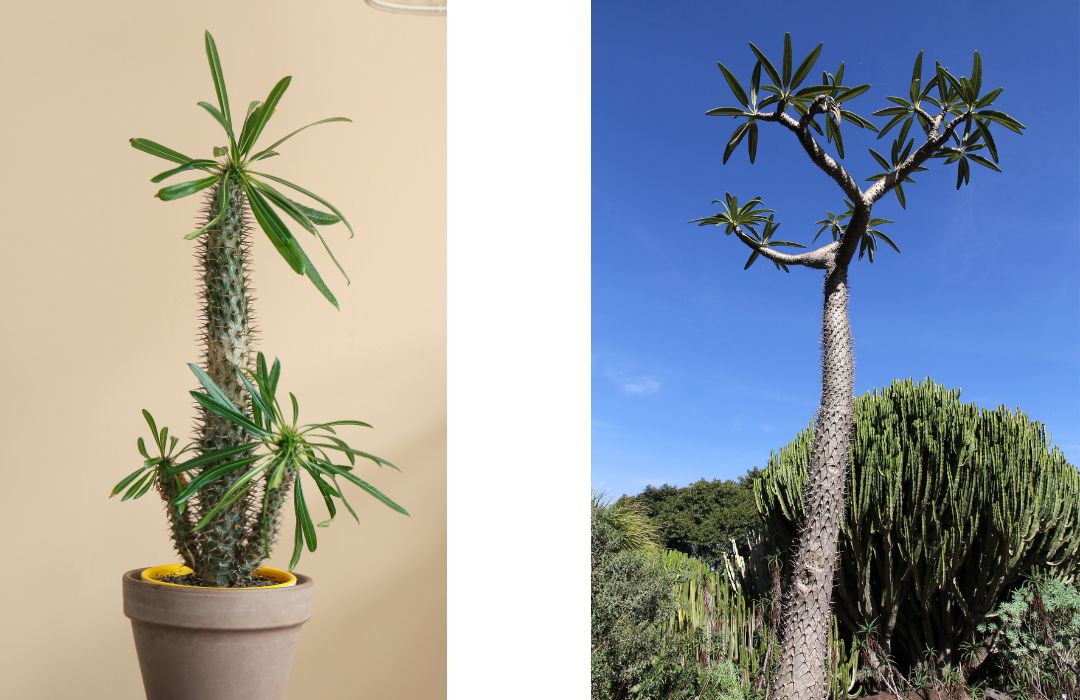
Pachypodium Lamerei (pak-uh-PO-dee-um) (la-MER-ee-eye) is another stem succulent that can get very tall. This plant can reach 20’.
The common name for this plant is Madagascar Palm. It is from, drum roll, Madagascar, which is off the east coast of Africa. Other names this tall succulent goes by are Summer-blooming clubfoot, Three-spined clubfoot, and Pachy.
This succulent, of course, is not a palm. But there is something palm-like in its long, dramatic trunk and the feathering of green leaves at the top. Also, much like a palm tree, this tall succulent likes warm weather. So if you’re not in zones 9A-11 you’ll want to keep the plant inside and in a sunny location.
A mature Pachypodium Lamerei, which would be about 10 years old, will start to flower in the summer with white scented, saucer-like blooms. Around this time the plant will start to branch out.
It is also interesting to note that the Madagascar Palm does its photosynthesizing mainly through its trunk. That’s good to know because there are so few leaves on this plant! Most plants, as we know, photosynthesize through their leaves, creating the food for the plant.
Madagascar Palm is fast growing, adding up to a foot to its height per year!
The numerous spines on the trunk of the plant are sharp, and all parts of the plant are poisonous if ingested. Which sounds worse than it is — because who in the world would want to take a bite out of this plant?
Unlike agaves and aloes, these tall succulents don’t store their water mainly in their leaves. These five tall succulents in this post are stem succulents, which store water in their stems. And, some of these stems, or trunks, can look pretty bloated.
Go Faux
You can get a fake potted Pencil Cactus that is 5’ tall or what looks like a 60” African Milk Tree. There’s an artificial Giant Yucca that’s nearly 5 ½’ tall. That’s one way to solve the plant maintenance problem.
We partner with select companies whose products and/or services we love. Some of the links on this page may be affiliate links. If you purchase an item using our affiliate link, we may receive a small commission (at no added cost to you). We appreciate your support.

